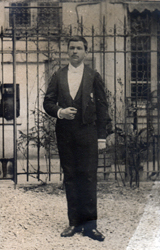Composer, Violinist, Pianist and Conductor (1881-1955)
Romanian composer, violinist, pianist, conductor and pedagogue, one of the most prominent musicians of the late twentieth century. of the 19th century and from the first half of the century. In the twentieth century, Enescu raised Romanian professional music to the level of universal music values.
Born in Liveni, near Dorohoi, he knew folklore from childhood through popular tapas. He received his first musical guidance from his parents and from a famous fiddler, Nicolae Chioru. between 1888 and 1893 he studied at the Vienna Conservatory with Joseph Hellmesberger (violin) and Robert Fuchs (composition), and between 1893 and 1899 in Paris with Andre Gedalge (counterpoint), Jules Massenet and Gabriel Faure (composition), as well as and with MPJ Marsick (violin). His composition creation addresses almost all musical forms and genres. Reflecting the love for the people among whom he rose and with whose sensitivity he identified, Enescu created a music with a clear popular, national and realistic character. Enescu’s work represents an example of the acquisition and creative development of the conquests of European musical art, of combining them with the traditions of Romanian folk music. Even in works in which German or French influences are manifested, or in those whose content does not necessarily imply the national form, as, for example, Suite I “in classical style” for piano and opera “Oedipus”, the connection with folklore can be seen. ours, by the use, sometimes discreet, sometimes quite obvious, of its modal, rhythmic forms, intonations. Enescu laid the foundations of our symphony, opening up great perspectives. Among his most notable works are: “The Romanian Poem” (1897), which embodies a series of paintings suggestive of rustic life; two “Roman Rhapsodies” (1901; 1902), characterized by a rich melodic line, of authentic folk origin and colorful orchestral attire; three suites for orchestra (including Suite III “Sateasca”, 1938), in which the folklore knows a subtle transfiguration; three symphonies (1905; 1913; 1919, the latter remade in 1921), which, through the maturity of the concept, the exceptional harmonic, polyphonic and orchestral mastery, through their dimensions, represent monumental sound frescoes; a Chamber Symphony for 12 solo instruments (1945), in which folklore reaches a high degree of refinement; a Concert Symphony for Cello and Orchestra (1901). Enescu also wrote works for chamber ensembles (two string quartets, 1912, 1952; two piano quartets 1909-1911, 1944; one byte for stringed instruments, 1900; one for a wind instrument, 1906) characterized by -an expressive melody, through unitary constructions, cohesive and through the transparency of the overall sonority; works for piano, cello and piano, as well as for violin and piano (including Sonata III “in Romanian popular character”, 1926; suite “Impressions from childhood”, 1940), which stands out by the balance between freedom of inspiration and discipline of form; lieds (including the cycle of lieds on lyrics by Clement Marot); processing and transcripts.
Starting from the well-known subject of the classical Greek tragedy, Enescu wrote, according to Ed. Fleg’s libretto, the work “Oedipus”. Enescu’s capital creation, it is crossed by a generous and intense emotional content and is distinguished by an evocative and dramatic poetic language. It also includes transpositions of some folkloric elements, in terms of a high generalization, with means of expression characteristic of contemporary western art. Under the later influence of some currents of French and German music and as a result of the preoccupations for finding new ways of expression, some of Enescu’s works, for example the Chamber Symphony, show in some places a more accentuated internalization and more abstract rendering of emotional content. As a violinist, his interpretive art was characterized by naturalness, sensitivity, richness of color, variety of shades and the combination of attention to musical substance with virtuosity. His repertoire included the entire literature of the instrument. In chamber ensembles, Enescu collaborated with P. Casals, J. Thibaud, A. Cortot, A. Casella, D. Oistrah and other notable artists.
As a pianist, his art was distinguished by a rich and refined palette and by the orchestral sonority of the performance. Enescu was one of the most important contemporary conductors. His conducting mastery is characterized by the depth of rendering the meaning of the work of art and by the sobriety, suppleness and expressiveness of the gesture. He was a remarkable interpreter of the creation of Bach, Mozart, Beethoven, R. Strauss, Brahms, Tchaikovsky, Wagner. Enescu spread abroad, along with his works that had acquired an indisputable international prestige, the creations of some of his compatriots, thus drawing attention to the young Romanian music school. As a pedagogue, Enescu guided and trained a number of famous instrumentalists (Dinu Lipatti, Yehudi Menuhin, Ida Handel, etc.). Enescu’s multilateral personality is integrated with his activity on a public level. in 1913 he founded, for the benefit of his concerts, the composition prize that bears his name and which has consecrated many leading exponents of Romanian music. in 1920 he was one of the founders of the Society of Romanian Composers and its first president. A representative of the advanced intellectuals, Enescu took a stand against Hitlerism during the Second World War.
Through his creation and activity, Enescu is among the most representative figures of the progressive Romanian culture. To honor Enescu’s memory, the Romanian government established the “George Enescu” Scholarship and established the “George Enescu” International Competition and Festival, which took place every three years, starting in 1958, in Bucharest. The house where Enescu lived became a memorial house; The “George Enescu” Museum was founded in the capital, and the artist’s native village and the Bucharest State Philharmonic are named after him. George Enescu was a member of the Romanian Academy as well as a corresponding member of the French Academy.


















